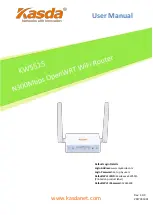
UTT Technologies Chapter 7 Advanced
http://www.uttglobal.com
Page 103
Chapter 7 Advanced
This chapter describes how to configure and use the advanced features of the Router,
which include NAT and DMZ, static route, policy routing, anti-netsniper, plug and play,
syslog and SNMP.
7.1
NAT and DMZ
This section describes the
Advanced > NAT&DMZ
page.
7.1.1 Introduction to NAT Features
7.1.1.1 NAT Overview
The NAT (Network Address Translation) is an Internet standard that is used to map one IP
address space (i.e., Intranet) to another IP address space (i.e., Internet). The NAT is
designed to alleviate the shortage of IP addresses, that is, it allows all the local computers
to share a single or a small group of IP addresses: On the Internet, there is only a single
network device using a single or a small group of public IP addresses; but the local
computers can use any range of private IP addresses, and these IP addresses are not
visible from the Internet. As the internal network can be effectively isolated from the
outside world, the NAT can also provide the benefit of network security assurance.
The Router provides flexible NAT features. The following sections describe them in detail.
7.1.1.2 NAT Address Space Definitions
To ensure that NAT operates properly, the Router uses and maintains two address
spaces:
●
Internal IP address:
It indicates the IP address assigned to a local computer by the
administrator. It is usually a private IP address.
●
External IP address:
It indicates the IP address assigned to the Router
’s Internet
connection by the ISP. It is a legal public IP address that can represent one or more
















































